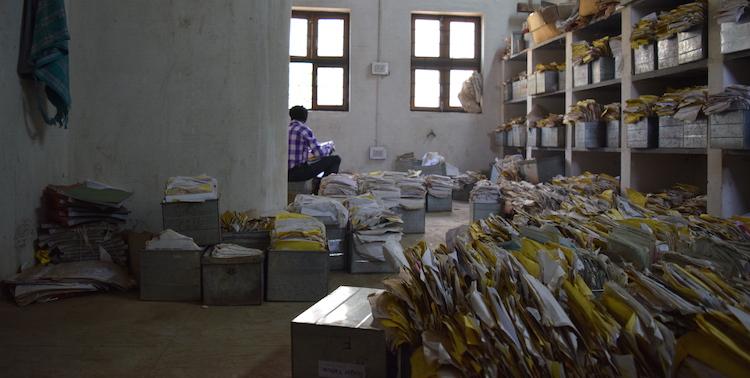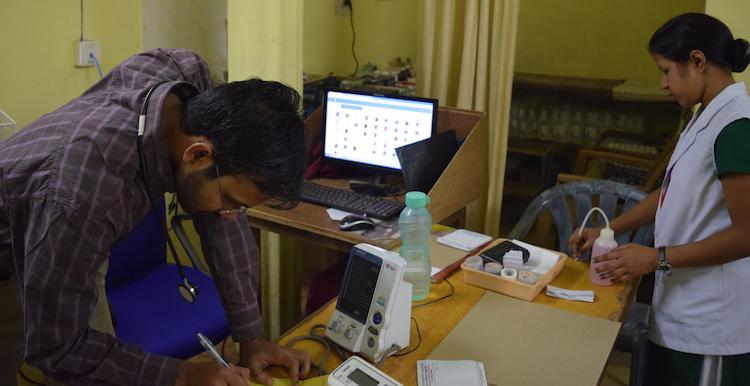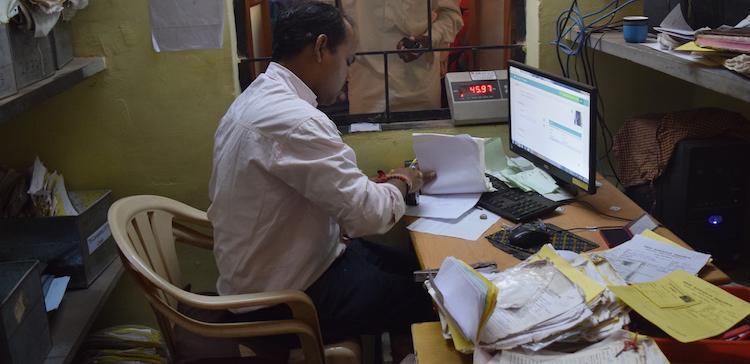
EMRs and Paper Records: Co-existing in Hospital Ecosystems

Today, Hospital Management Systems (HMIS) and Electronic Medical Record Systems (EMRs), while common in urban areas and commercial hospitals, are increasingly being considered for use in rural hospitals. Despite infrastructure and technical literacy constraints, there is an increasing demand for EMRs to be implemented and used in remote hospitals. The success of the adoption of such systems is often tied to eliminating paper use in various departments in the hospital. We would like to propose that instead of asking the question, “how can we use an EMR to eliminate paper”, we should be asking “how can we use an EMR to complement and fill in the gaps of the current, paper driven, clinical and hospital processes”.
As a medium, paper has historically been a reliable tool for clinicians because it allows them the freedom to capture less structured free text for patient history, and enables them to record pictorial observations. Paper also acts as a crucial communication tool among hospital staff. Hence, when introducing an EMR into the ecosystem of a hospital, the administrators should identify areas where an EMR can bring benefits to clinical care, while continuing to use paper in order to leverage the proven benefits of both systems. Jürgen, Dietrich, et al, concluded that “medical professionals should be cognizant of the possible discrepancies between paper and electronic information and look towards combining information from both records whenever appropriate”.1
Clinical Processes

While facilitating patient care, there is a need for constant communication and coordination between clinicians in the hospital. The process of recording information on paper facilitates intra-clinician communication in the social context in the hospital. For example, in the in-patient department, where care is provided round the clock, observation data is captured on a clipboard and hung at the patient’s bed. Along with this data, clinicians write notes and make annotations that act as “call outs” to the doctors and nurses on the next shift. These “call outs” direct them to focus on specific patient details. With paper, the decision making process of one clinician is captured and passed along to the next clinician caring for the patient.
EMRs, by design, focus more on enabling clinicians to capture notes specific to patient care and less as a channel for communication between providers about a particular patient’s record. However, what it lacks in its ability as a tool for intra-clinician communication, it makes up as a way for providing a unified patient summary at all times.
While developing Bahmni, we found that although patient records on paper traveled through the various departments of the hospital, they could only be viewed by the person with the record in hand. For example, a radiologist adding his notes while reporting an x-ray result may want to check if the result is actually indicative of a trend, but may not have immediate access to the patient record that currently in the possession of the attending general physician. An EMR provides the hospital staff with a transparent single view that can be accessed by multiple people at the same time. This provides a more holistic understanding of the most up to date patient data, while connecting the entire hospital ecosystem.
Patient files are often filled with data such as their medication orders and dispositions, with their clinical history interspersed. In order for clinicians to derive trends from this data they sometimes need to refer to as much as a decade's worth of a patient's medical history, taking significant time to flip through the pages of a physical, paper based, medical record. However, with the introduction of an EMR, such as Bahmni, hospital staff no longer have to piece this information together manually. Instead, they have the ability to view a patient's health summary holistically, over a chosen period of time.
With the use of paper, data like temperature, Body Mass Index (BMI), Body Surface Area (BSA), and World Health Organization (WHO) growth charts, are computed and plotted into graphs by hand, a process that is time consuming and prone to error. With an EMR, hospital staff can leverage patient history and create visual trends, enabling them to view observations such as those mentioned above in a visual format. Values like BMI and BSA can be automatically computed based on the patient’s height and weight. This provides clinicians with an instantaneous insight into the progress of a patient over a period of time.
Clinicians at point of care make crucial decisions, but rely on a process that is time consuming and error prone (such as creating and using manual chart abstractions).They take into account, things like drug interactions, overdue laboratory and radiology tests to ensure safety and quality of care for patients. With the assistance of an EMR based clinical support system, errors are reduced by the use of preset triggers which help in making key decisions. The use of a computer based system improves the consistency and reliability of decision support systems by minimising labour intensive and error prone processes (Kawamoto, Kensaku et al.).2
Clinicians can automatically be provided decision support as part of their workflow, with specific recommendations based on the patient’s clinical information and history. For example, if a tuberculosis patient hasn’t had an x-ray taken in over an year, an alert can be provided reminding the clinician to order one. The system would also factor in other important information to prevent events such as a clinician inadvertently ordering an x-ray for a pregnant woman. Alerts such as these, although seemingly simple, can be invaluable in providing quality care and patient safety.
Departments offering specialized care such as dentistry, psychology and oncology need to record specific data to impart focused care to the patient. With an EMR, such information is usually captured using specifically designed forms. EMRs supplement paper records in these departments by enabling clinicians to access information in a structured format, that is specific to their department. Access to patient data, history, trends and diagnostics pertinent to their department helps increase the quality care, as it provides the clinician with a view that is most relevant to them. Doctors no longer need to sift through information from other departments and can look at information grouped for their specific consumption.
For this purpose, we built the functionality to add and configure patient dashboards for every department and every user in Bahmni. For example, a obstetrician’s dashboard can be set up to first view only pregnancy history and subsequently, other information.
Hospital Operations

Efficient and quick access to patient information is not only important at the clinical level, but also at the administrative level. Hospital administrators use data such as the number of patients receiving ambulatory care, new admissions and volume of surgeries performed, to arrive at the cost of care per patient. Traditionally, this information has been recorded by individual departments in physical registers and hospital administrators rely upon these records for analysis. This information may be fed periodically into spreadsheets for deriving aggregates and for predicting trends. While they may continue to capture some of this information in paper format for audit and traceability purposes, hospital management systems can help provide robust computation and the ability to analyse and predict trends.
For example, hospitals spend a large portion of their budget on drug costs and management systems. These can be used to strike the right balance between stocking appropriate quantities of drugs and reagents to meet daily requirements, while minimizing expiring stock and excess inventory. The actual tenders and purchase orders can be maintained on paper for ease of communication with vendors.
At an organizational level, every hospital has a need for generating reports that can be used for research, fundraising, improving clinical care, or lobbying the government. Häyrinen, Saranto and Nykänen found that “the quality of information is particularly important in patient care, but EHRs also provide important information for secondary purposes, such as health policy planning”.3
Paper is the primary means of data collection in the field, especially by community health workers at the grassroots. As a medium, it has its distinct advantages as it has low barrier to entry. Anyone can be easily trained to collect data using paper. Paper is also a cost effective means of data collection and is easy to store and transport.
But once the data collection is complete and that information is fed into a hospital management system, it is the EMR that supports reporting by easing compilation and analysis. In addition, systems like Bahmni that hold diagnostic and other care plan data, can intuitively provide summary reports. Instead of requiring hospital staff to pore over thousands of patient files and painstakingly put reports together, EMRs enable them to create and access summaries and trends quickly.
Skill Development and Training

Traditionally, residents, junior doctors and clinicians-in-training learn on the job, with the aid of classroom trainings and by shadowing senior clinicians. Hospitals have been looking to integrate modern methods of training and education into the clinical workplace. An EMR can augment this process as a training tool for residents and other staff. Help text and hints can suggest what questions need to be asked during consultations and highlight what information needs to be captured for patients with particular ailments. This functionality is two-fold, in that, it not only ensures that relevant patient data is captured, but also helps residents gain valuable diagnostic skills.
Conclusion
Information systems are becoming ubiquitous in hospitals and healthcare facilities all around the world. These systems complement paper in hospitals by providing features such as clinical decision support and visual trends that fill the gap crucial to patient care. A diverse group of stakeholders derive value from these systems in a myriad of ways. Doctors and clinicians use EMRs for improving quality of healthcare and reducing time in processes. Administrators use these systems to decrease costs and improve operational efficiency. Trainees utilize these as tools for learning and development.
When used together, paper and EMRs can create a complete view of patient information needed to provide effective and efficient care.
An EMR should complement existing paper driven hospital processes for effective health care
References
- Stausberg, J., Koch, D., Ingenerf, J., Betzler, M. Comparing paper-based with electronic patient records: lessons learned during a study on diagnosis and procedure codes. J. Am. Med. Inf. Assoc.2003;10:470–477. [View article]
- Kawamoto K, Houlihan CA, Balas EA, Lobach DF. Improving clinical practice using clinical decision support systems: a systematic review of trials to identify features critical to success. BMJ 2005; 330:765. [View Article]
- Hayrinen K, Saranto K, Nykanen P Definition, structure, content, use and impacts of electronic health records: a review of the research literature. International journal of medical informatics 77.5 (2008): 291-304. [View Article]
Editing Credits: Punith M. Prasad
Disclaimer: The statements and opinions expressed in this article are those of the author(s) and do not necessarily reflect the positions of Thoughtworks.














